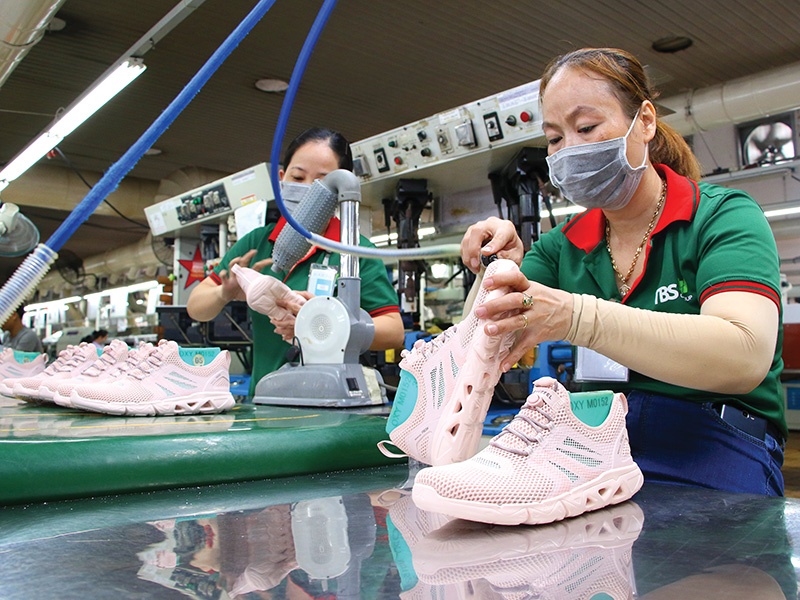Footwear giants a step ahead in production restart
 |
| Vietnam is a key hub for global footwear behemoths such as Nike |
Around 200 Nike subcontractors in Vietnam have finally resumed production after the Delta variant caused temporary factory closures this summer. The sportswear giant intends to ramp up its production even further in Vietnam, according to chief sustainability officer Noel Kinder.
Nguyen Chi Trung, vice chairman of the Vietnam Leather and Footwear Association (LEFASO), said that groups like Nike continue to believe in Vietnam as one of the best places to provide quality footwear products to meet the needs of their customers. Having placed trust in Vietnam’s strategy to fight against the pandemic, according to Trung, major footwear groups are signing contracts with Vietnamese partners rather than moving orders out of the country.
Trung added that about 70-80 per cent of workers have returned to work at factories in Vietnam’s southern industrial zones in provinces such as Binh Duong, Dong Nai, and Long An. However, the lack of human resources will hinder factories from achieving full capacity. “There is also the risk of potential outbreaks as factories revive operations, and anxiety among workers about the pandemic will likely affect the quality of products,” Trung warned.
Vietnam’s footwear industry is labour-intensive, so many companies were forced to temporarily halt operations because they failed to accommodate large amounts of workers under stay-at-work models. The supply chain was disrupted for four months during social distancing measures, ultimately causing delays in product delivery and dampening buyers’ trust in Vietnamese market.
Le Quoc Thanh is general director of Feng Tay Group, which boasts five factories in Dong Nai with over 64,000 workers. After one month of resuming production in October, after all its factories were forced to close, Thanh noted that 80 per cent of workers had returned. “We don’t lack year-end orders from foreign brands but our challenge now is to recruit enough workforce to achieve 100 per cent capacity,” Thanh said.
In the same vein, a representative of Gia Dinh Footwear said that the company has reopened five factories in southern Vietnam to supply products to overseas buyers like Mango, Clarks, and Polo. The company, which employs 5,000 people, was able to produce up to half a million pairs of shoes per month for export before the pandemic emerged. However, it can only currently fulfil 70 per cent of its orders.
Meanwhile, 70 per cent of the workforce has so far returned to Pou Chen Corporation, a major Nike manufacturing partner. Pou Chen closed its factory in Ho Chi Minh City in July because of rising infections among its workers, and the company could not comply with stay-at-work methods due to the huge number of workers at its disposal.
Many factory owners have said they only expect to fully resume operations from the second half of 2022. At the moment, they are striving to fulfil a moderate number of orders for the Christmas and New Year seasons in overseas markets.
Trung from LEFASO stated that the main challenges for Vietnam’s footwear industry when reopening is to maintain orders and retain foreign buyers. “The country must keep the supply chain undisrupted in upcoming outbreaks,” he said. “If Vietnam can contain the pandemic and ensure safe living with COVID-19, foreign brands will be here to stay with Vietnam rather than moving orders to China, India, or Bangladesh.”
Trung noted that, for example, Ho Chi Minh City Department of Health announced guidance to separate F0 coronavirus cases at factories so that production activities can be continued – which reflects the efforts of the government and health ministry to avoid further supply chain disruption and offers up a positive outlook. “Indeed, we have seen positive signs for Vietnam’s footwear industry. Exports should recover by year-end thanks to rising orders. In 2022, the industry is expected to rebound strongly from the pandemic brought by a wide range of free trade agreements Vietnam has signed,” Trung added.
What the stars mean:
★ Poor ★ ★ Promising ★★★ Good ★★★★ Very good ★★★★★ Exceptional
 Tag:
Tag:
Related Contents
Latest News
More News
- Opening remarks of 14th National Party Congress (January 20, 2026 | 09:44)
- First working day of 14th National Congress of Communist Party of Vietnam (January 19, 2026 | 08:54)
- Viettel starts construction of semiconductor chip production plant (January 16, 2026 | 21:30)
- Redefining Vietnam’s growth model for the era of innovation (January 16, 2026 | 16:40)
- Foreign sentiment towards Vietnam turns more positive (January 15, 2026 | 11:08)
- Vietnam ranks 38th in global AI adoption (January 14, 2026 | 16:01)
- European business confidence reaches highest in seven years (January 13, 2026 | 10:17)
- UOB lifts Vietnam growth outlook to 7.5 per cent for 2026 (January 10, 2026 | 09:00)
- Vietnam leads ASEAN in EV market growth (January 09, 2026 | 14:39)
- Electronics drive Vietnam’s trade growth as exports hit record in 2025 (January 07, 2026 | 10:23)






















 Mobile Version
Mobile Version